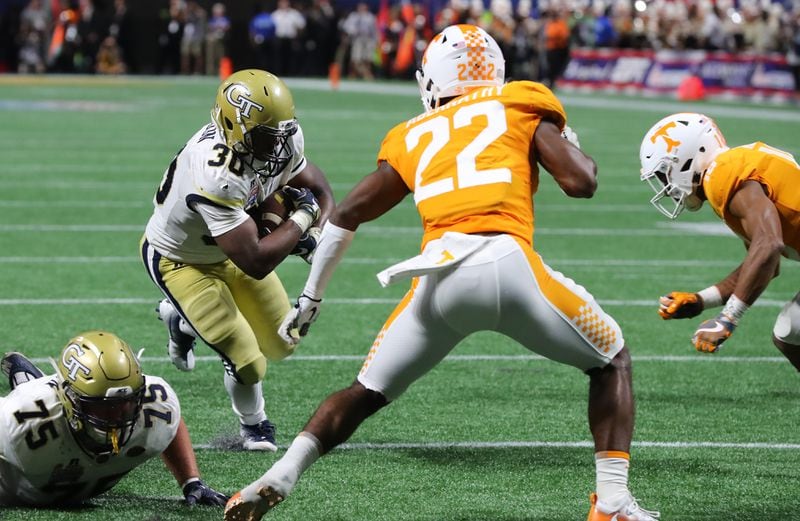On Tuesday, Georgia Tech coach Paul Johnson allowed that, after the first two series of the season opener against Tennessee, the offense’s execution was “pretty good.” This qualifies as high praise from Johnson.
In 2011, after Tech set school modern-era records for rushing yards (604), total offense (768) and scored nine touchdowns and one field goal in its first 11 possessions against Kansas, Johnson said that “they played fairly well the whole game offensively.”
On offense, Tech’s performance Monday night at Mercedes-Benz Stadium is close to the top, and comparing it against Johnson’s nine-year tenure bears it out. For the sake of an apples-to-apples comparison, the statistics at the end of regulation were used. The rankings are against other power-conference teams. Rankings from sports-reference.com and cfbstats.com.
Rushing yards: 485. Rank: 2
Yards per carry: 6.2. Rank: 24
Total offense: 605. Rank: T4
Plays: 87. Rank: 3
Yards per play: 7.0. Rank: 22.
Third-down percentage: 68.8 percent. Rank: 5
Time of possession: 41:27. Rank: 4.
Negative-yardage plays: 1. Rank: T2
What was perhaps most distinguishing about Tech’s offensive game against Tennessee wasn’t necessarily the total yardage, impressive as it was. That was a factor of repeatedly playing long fields. Out of 12 regulation possessions, Tech started at its 25-yard line or inside it 10 times.
What was perhaps more noteworthy about Tech’s play in this game was the play-to-play consistency. Behind effective line play – a starting five of Jahaziel Lee and Jake Stickler at tackle, Parker Braun and Will Bryan at guard and Kenny Cooper at center, along with a strong effort from guard Shamire Devine off the bench – Tech kept the ball moving forward, as the one negative-yardage play (an errant pitch from quarterback TaQuon Marshall to A-back Qua Searcy) would attest.
It wasn’t done with explosive plays, as is often the case. Big-yardage plays take pressure off the offense to have to continually take care of the ball, make blocks and make the right reads. Tech could not rely as much on that against Tennessee as it often can.
The Jackets accumulated those yards with only five plays of 20 yards or more out of 87 snaps in regulation. It’s not bad, but last season, Tech had a 20-yard run or pass once every 11.7 snaps against power-five teams. Its rate against Tennessee in regulation was one per 17.4 plays.
Tech’s longest touchdown play in regulation was six yards. B-back KirVonte Benson’s longest run in 26 carries was 15 yards. But he piled up 124 yards while getting tackled for a loss only once.
Tech’s 7.0 yards-per-play average was excellent, but not outstanding compared against the most efficient games in the Johnson era. However, it was compiled with a much higher number of plays than the norm and without many big plays to inflate the rate, giving a clearer picture of how consistent the offense was.
What might distinguish this game the most was the 11-for-16 performance on third downs in regulation, notable both for the rate of conversion, 69 percent, as the volume. The four games that ranked ahead of Monday night’s game for third-down efficiency are among the best in Johnson’s tenure – the 58-23 win over N.C. State in 2014 (Tech converted a third-and-10 against the Wolfpack with a triple-option play), the Orange Bowl win at the end of that season, the lightning-impeded 49-44 win over Florida State in 2009 and the aforementioned blowout of Kansas. In those four games, Tech didn’t face more than 13 third downs.
Tech actually converted another two in overtime Monday night, lifting the rate to 72 percent, which ranks third highest in Johnson’s tenure against power-five teams.
What helped was being in advantageous third downs. Out of 16 third downs in regulation, Tech was in third-and-4 or shorter eight times (converting seven) and in third-and-9 or longer just twice. Marshall converted both with a 10-yard run and a beautiful touch pass to wide receiver Ricky Jeune for a 44-yard gain.
All of that effectiveness, of course, was for naught in the 42-41 double-overtime loss. Two missed field goals and two lost fumbles, one by Marshall and the other by A-back J.J. Green, both of which were converted into touchdowns, were costly.
The latter fumble, lost at the Tennessee 25-yard line with about five minutes to play, quashed an opportunity to go up two scores late in the game.
Ultimately, from a scoring perspective, it was rather inefficient. Tech had 11 possessions in regulation (not counting a negligible drive at the end of the first half) and came up empty on seven (two missed field goals, two lost fumbles, three punts).
On 11 drives, Tech scored 2.5 points per possession in regulation, which is good, particularly given the field position. But it's not great. The Jackets' average last season against FBS opponents was 2.6, according to bcftoys.com.
Tech was able to move the ball consistently about as well as it ever has in Johnson’s tenure, an encouraging sign for the rest of the season. To utilize that apparent strength, keeping the ball secure and improving the kicking game will be imperative.
About the Author







